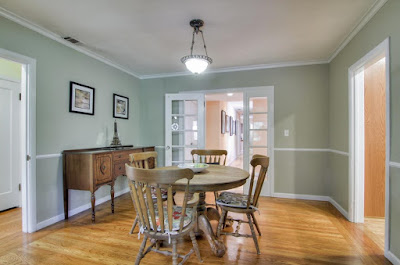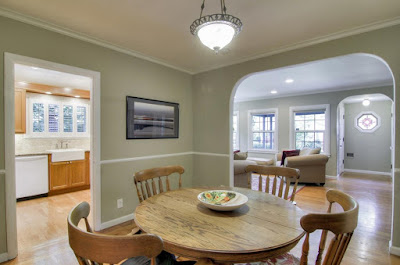 |
| Star Road and White Sun by Ernest L. Blumenschein c.1920, Albuquerque Museum |
Since I've been on this dwelling theme for a while, why not continue for a bit longer, eh?
I was back in Taos over the weekend to pick up Ms. Ché who'd finished her writers' conference, and we decided to stop at the Blumenschein House on our way out of town to compare and contrast it with the Couse House which we'd visited the prior weekend.
Blumenschein, together with Bert Phillips, started the process of making Taos into the place it is today when their famous Wagon Wheel broke a couple of dozen miles from town and Blumenschein won the toss to take it into the hamlet somewhere down below them to get it fixed. They had to wait, as one can imagine there in the middle of nowhere, and so they did.
While waiting, they became enchanted, so the story goes, and they spent the rest of the summer awestruck and delighted, painting up a storm, and pondering their own futures.
Phillips stayed in Taos the rest of his life. Having settled in, there's no other place he'd rather be. Blumenschein went back to Paris where Joseph Henry Sharp had told him and Bert about the enchantment to be found in Northern New Mexico, and one thing led, eventually, to another, and all of them wound up living and working in Taos at least part time, and Blumenschein and his wife Mary settled in themselves, purchasing Buck Dunton's place (or part of it) on Ledoux St, where they set up quarters of a sort and a studio in four ancient rooms said to have been a part of the village defenses against the Indians when time was.
I won't go into that history, but quite a few of the Spanish settlements in Tierra Adentro were consciously built as fortresses, and the village of Taos was no exception. The Indians were wild back in the day, particularly Kiowa, Comanche, Apache and Navajos.
The appropriate tangent at this point is to mention that there are three distinct "Taos"-es. There is the ancient Indian Pueblo at the foot of the Mountain; there is the village some three or four miles south; then there is Ranchos de Taos, several miles south of the village, where stands San Francisco de Asis mission church that's been painted by Georgia O'Keeffe dozens of times and by other painters endless numbers of times. Side note: Dennis Hopper is buried in Ranchos de Taos, and his grave is a pilgrimage site for a diminishing number of aging Easy Riders.
Surrounding all of this is an amorphous outlying settlement area dotted with ranches and ranchettes and earthships and what have you where by far the largest number of Taoseños currently live scattered to the winds perhaps, but partaking in their own way the essence of that Sacred Placewhere they don't have to mix too much with the tourists.
At least it's not as bad as Sedona.
Anyway, none of the Taoses would be what they are today without Bluemschein and Phillips and the other members of the Taos Society of Artists and their numerous offshoots and successors and the many other influencers who have passed through or settled there since that fateful Wagon Wheel broke in the summer of 1898.
Blumenschein returned to Taos in the summertime for years, but he lived in Paris or New York, making money as a successful illustrator for magazines and books, until 1919 when he purchased "four rooms" from Buck Dunton, another member of the Taos Society, and settled in, or at least tried to. This was like camping out for the Blumenscheins and most of the other artists attracted by the Blumenscheins and others to Taos. The four rooms were built of mud and timbers, some of the structure apparently among the oldest still standing in the village, they had little heat, no electricity or indoor plumbing, and like everything else in Taos they were at the edge of Nowhere. It's hard to explain how difficult it was to get to Taos from anywhere else, and to get from Taos to anywhere else. This isolation was both a handicap and a blessing.
The house as it stands today is a rambling L shaped structure around a lush courtyard, in one corner of which is Buck Dunton's studio -- which he apparently kept even after all the other rooms on the property had been purchased by the Blumenscheins. This part of the story is a little confusing to me. Apparently Buck bought part of the rambling structure from earlier residents, but most of the structure was owned by and lived in by long-time Hispanic residents who one by one were persuaded to vacate by Blumenschein's offers of cash money. At least that's how I interpret the story of how Ernest Blumenschein eventually acquired the entire property.
This is a pattern that repeats over and over again -- even now --throughout the fancier and more tourist oriented areas of New Mexico. It's a form of gentrification, pushing out the original settlers and descendants to make way for the shiny, sophisticated newcomers. "Sophisticated" is the key.
The Blumenscheins were nothing if not sophisticated, and yet their mud house on Ledoux Street is a curious amalgam of its primitive Hispanic roots and the high style that the Blumenscheins had acquired in Paris and New York. Curiously, there's almost no Native influence in the house at all, though apparently they employed Native servants as well as Hispanic ones (this was typical of the art colony.)
The Couse house shows lots of Native influence or at least artifacts, and Mabel's Place up the road from the Couse House was built by Native artisans from the Pueblo, and of course, Mabel was married to Tony Luhan (who had his own house on the property) who was born and raised (and had another wife and children) on the Pueblo.
There are a number of other Taos Society historic sites to explore, and eventually we may get to them, or not. I started my explorations of this sort many years ago at La Fonda de Taos where I stopped one evening to take in the D.H.Lawrence scandalous paintings. The ones there now are reproductions, but I saw the originals... and to be kind, I wasn't moved. But it started my journey to learn more about the artistic history of Taos.
It's a story of colonizers and colonization, one that has transformed some of New Mexico yet has left much of the rest of the state practically untouched.
On our way back from Taos this past Sunday we stopped off at the Santuario de Chimayó where a large group of East Indian pilgrims was taking all the Holy Dirt out of the Holy Dirt Pit and transporting it away in gallon containers. There seemed to be none left for the other pilgrims. We sat beside the abandoned crutches and Santo Niño and shook our heads in wonder and wiped the sweat from our brows as the heat and humidity of the day was surprisingly intense. We nodded to the statue of Father Roca in the courtyard. His generosity of spirit will live on....

























